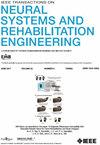通过联合协同注意算法分析疾病引起的人体运动模式变化
IF 4.8
2区 医学
Q2 ENGINEERING, BIOMEDICAL
IEEE Transactions on Neural Systems and Rehabilitation Engineering
Pub Date : 2025-04-23
DOI:10.1109/TNSRE.2025.3563466
引用次数: 0
摘要
目的:为了量化和分析人类运动中疾病引起的改变,我们通过基于视觉的联合协同注意算法来探索运动中的联合协同模式。方法:我们招募了30名参与者(包括15名卒中后患者和15名健康个体),通过串行注意模块提取关节特征耦合的3D视觉运动数据。基于数据的时空特征,设计了双流分类模块进行预分类。然后通过循环掩模和协同变异性评分提取重要的协同模式。结果:通过联合协同注意算法,我们发现脑卒中后患者与健康个体在上肢和下肢任务时的联合协同模式存在显著差异。此外,我们还获得了特定疾病对健康个体和患者之间联合协同模式影响的定量结果。通过与常用的非负矩阵分解(NMF)和肌肉协同分解(MSF)方法进行比较,验证了结果的有效性。结论:特定疾病可引起人体运动模式的变化,通过联合协同关注算法可以分析联合协同的变化,并量化不同协同组的重要性。意义:本研究提出了一种识别疾病改变生物力学引起的特定协同协同模式的新方法,为康复过程提供了一种新的靶向方案。本文章由计算机程序翻译,如有差异,请以英文原文为准。
Analysis of Disease-Induced Changes in Human Locomotor Patterns Through the Co-Joint Synergistic Attention Algorithm
Objective: Aiming to quantify and analyze disease-induced alterations in human movement, we explored the co-joint synergy patterns in locomotion through a vision-based co-joint synergistic attention algorithm. Methods: We recruited 30 participants (including 15 post-stroke patients and 15 healthy individuals) and extracted their 3D visual motor data for the joint feature coupling by a serial attention module. And we designed a dual-stream classification module for preclassification based on the spatio-temporal characteristics of the data. Then we extracted the important co-joint synergy patterns by a looping mask module and the co-joint synergy variability score. Results: Through the co-joint synergistic attention algorithm, we found significant differences in joint synergy patterns between post-stroke patients and healthy individuals during upper and lower limb tasks. Furthermore, we obtained quantitative results on the effect of specific diseases on co-joint synergy patterns among healthy individuals and patients. The validity of the result was verified by comparing with the commonly used Non-negative Matrix Factorization (NMF) and the Muscle Synergy Fractionation (MSF) methods. Conclusion: Specific diseases can cause changes in human movement patterns, and by the co-joint synergistic attention algorithm we can analyze the alterations in joint synergies and also quantify the importance of different synergy groups. Significance: This research proposes a new approach for identifying specific co-joint synergy patterns arising from disease-altered biomechanics, which provides a new targeted protocol for the rehabilitation process.
求助全文
通过发布文献求助,成功后即可免费获取论文全文。
去求助
来源期刊
CiteScore
8.60
自引率
8.20%
发文量
479
审稿时长
6-12 weeks
期刊介绍:
Rehabilitative and neural aspects of biomedical engineering, including functional electrical stimulation, acoustic dynamics, human performance measurement and analysis, nerve stimulation, electromyography, motor control and stimulation; and hardware and software applications for rehabilitation engineering and assistive devices.

 求助内容:
求助内容: 应助结果提醒方式:
应助结果提醒方式:


